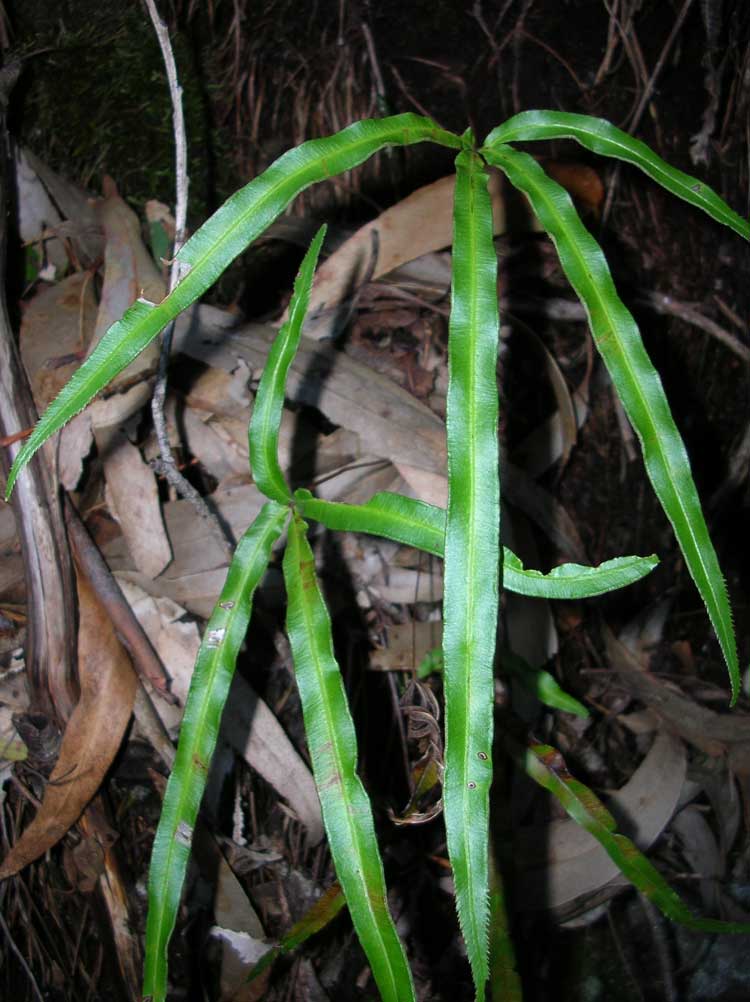
Pteris cretica (Photo: Forest & Kim Starr)
Superregnum: Eukaryota
Regnum: Plantae
Divisio: Tracheophyta
Divisio: Pteridophyta
Classis: Polypodiopsida
Ordo: Polypodiales
Familia: Pteridaceae
Subfamilia: Pteridoideae
Genus: Pteris
Species: Pteris cretica
Subspecies: P. c. subsp. cretica – P. c. subsp. laeta
Name
Pteris cretica L., Mant. Pl.: 130 (1767).
Synonyms
Homotypic
Pycnodoria cretica (L.) Small, Ferns Florida: 91 (1932).
Distribution
Native distribution areas:
Continental: Europe
Regional: Northern Europe
Great Britain.
Regional: Middle Europe
Hungary, Netherlands, Switzerland.
Regional: Southwestern Europe
Corse, France, Sardegna, Spain.
Regional: Southeastern Europe
Greece, Italy, Sicilia.
Regional: Eastern Europe
Krym.
Continental: Africa
Regional: Northern Africa
Algeria.
Regional: Macaronesia
Azores, Canary Islands.
Regional: West-Central Tropical Africa
Burundi, Rwanda, Zaire.
Regional: Northeast Tropical Africa
Ethiopia, Socotra.
Regional: East Tropical Africa
Kenya, Tanzania, Uganda.
Regional: South Tropical Africa
Angola, Malawi, Zambia, Zimbabwe.
Regional: Southern Africa
Cape Provinces, Lesotho, KwaZulu-Natal, Free State, Swaziland, Northern Provinces.
Regional: Middle Atlantic Ocean
Ascension, St.Helena.
Regional: Western Indian Ocean
Madagascar, Réunion.
Continental: Asia-Temperate
Regional: Caucasus
Transcaucasus.
Regional: Western Asia
Afghanistan, Iran, Lebanon-Syria, Turkey.
Regional: Arabian Peninsula
Yemen.
Regional: China
China South-Central, China North-Central, China Southeast, Tibet.
Regional: Eastern Asia
Japan, Korea, Nansei-shoto, Taiwan.
Continental: Asia-Tropical
Regional: Indian Subcontinent
Assam, Bangladesh, East Himalaya, India, Nepal, Pakistan, Sri Lanka, West Himalaya.
Regional: Indo-China
Cambodia, Laos, Myanmar, Thailand, Vietnam.
Regional: Malesia
Lesser Sunda Islands, Philippines, Sulawesi.
Continental: Australasia
Regional: Australia
New South Wales.
Regional: New Zealand
New Zealand South.
Continental: Pacific
Regional: North-Central Pacific
Hawaii.
Continental: Northern America
Regional: Southwestern U.S.A.
California.
Regional: Southeastern U.S.A.
Florida, Louisiana, Maryland.
Regional: Mexico
Mexico Central, Mexico Northeast, Mexico Gulf, Mexico Northwest, Mexico Southwest, Mexico Southeast.
Continental: Southern America
Regional: Central America
Costa Rica, El Salvador, Guatemala, Honduras, Nicaragua, Panama.
Regional: Caribbean
Jamaica.
Regional: Western South America
Colombia, Peru.
References: Brummitt, R.K. 2001. TDWG – World Geographical Scheme for Recording Plant Distributions, 2nd Edition
References
Primary references
Linnaeus, C. 1767. Mantissa Plantarum. Generum editionis VI. et Specierum editionis II. [1]: 1–142 + index (2 pp.). Holmiae. BHL Reference page.
Links
Govaerts, R. et al. 2021. Pteris cretica in Kew Science Plants of the World online. The Board of Trustees of the Royal Botanic Gardens, Kew. Published online. Accessed: 2021 Oct 13. Reference page.
Tropicos.org 2021. Pteris cretica. Missouri Botanical Garden. Published online. Accessed: 13 Oct 2021.
International Plant Names Index. 2021. Pteris cretica. Published online. Accessed: 13 Oct 2021.
Hassler, M. 2021. World Ferns. Checklist of Ferns and Lycophytes of the World. . Pteris cretica Accessed: 13 Oct 2021.
Hassler, M. 2021. Pteris cretica – World Ferns: Checklist of Ferns and Lycophytes of the World . In: Roskov Y., Orrell T., Nicolson D., Bailly N., Kirk P.M., Bourgoin T., DeWalt R.E., Decock W., De Wever A., Nieukerken E. van, Zarucchi J. & Penev L. (eds.) 2021. Species 2000 & ITIS Catalogue of Life. Published on the internet. Accessed: 2021 Oct 13.
USDA, ARS, Germplasm Resources Information Network. Pteris cretica in the Germplasm Resources Information Network (GRIN), U.S. Department of Agriculture Agricultural Research Service. Accessed: 08-Apr-12.
Pteris cretica, the Cretan brake,[1] ribbon fern,[2] or Cretan brake fern, is a species of evergreen fern in the family Pteridaceae, native to Europe, Asia and Africa.
Description
The fern grows to 75 cm (30 in) tall by 60 cm (24 in) broad. It has arching pinnate fronds each bearing up to five pinnae.[3][4]
Cultivation
Pteris cretica is cultivated widely by plant nurseries. It is used in gardens in the ground and as a potted plant, and as a houseplant. The variety with variegated foliage, Pteris cretica var. albolineata, is also widely used, brightening shade gardens.
Both types thrive year round outdoors in subtropical climates, such as California. With a minimum temperature of 2 °C (36 °F), both require protection from frost, though the species is hardier and can be grown outdoors during the summer months in cold climates.[3]
The species,[5] and the variety P. cretica var. albolineata (syn. P. nipponica),[6] have both gained the Royal Horticultural Society's Award of Garden Merit.[7]
A relictual presence is certificated in the Italian peninsula Lazio (Ponte Terra gorge, San Vittorino, Rome).
References
USDA, NRCS (n.d.). "Pteris cretica". The PLANTS Database (plants.usda.gov). Greensboro, North Carolina: National Plant Data Team. Retrieved 31 January 2016.
BSBI List 2007 (xls). Botanical Society of Britain and Ireland. Archived from the original (xls) on 2015-06-26. Retrieved 2014-10-17.
RHS A-Z encyclopedia of garden plants. United Kingdom: Dorling Kindersley. 2008. p. 1136. ISBN 978-1405332965.
"Missour Botanical Garden - Pteris cretica". Retrieved 27 June 2013.
"RHS Plant Selector - Pteris cretica". Retrieved 17 February 2021.
"RHS Plant Selector - Pteris nipponica". Retrieved 22 February 2021.
"AGM Plants - Ornamental" (PDF). Royal Horticultural Society. July 2017. p. 82. Retrieved 23 September 2018.
Retrieved from "http://en.wikipedia.org/"
All text is available under the terms of the GNU Free Documentation License

